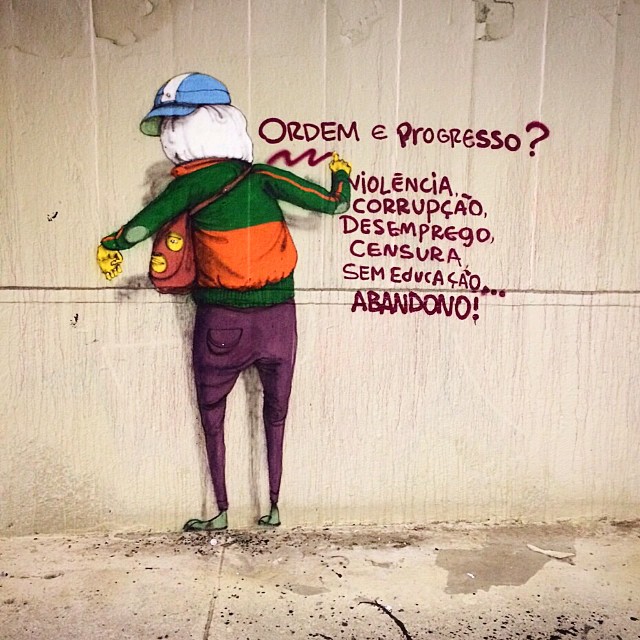When emergence goes far…
Posted on October 29, 2017All over the past weeks, we have been discussing about wicked problems, emerging systems, bottom-up strategies and solutions, open source. Thus, I’ve been reflecting a lot about the current political and economical scene in Brazil.

Os Gêmeos, “Ordem e Progresso”. Order and Progress? Violence, corruption, Unemployment, Censure, No Education… Abandon!
I will not extend myself in this complicated-boring topic but to give a better context in a brief form, the country has an extended government corruption history from many decades, meanwhile, the past years things started to get out of control and in 2016, we had an president’s impeachment[1]. Then, the vice president took the place and some might say it was a coup. Finally, at this point, everyday (yes, everyday) we have a new political scandal and a more divided country.
Personally, I am not a political engaged person. What I think is fascinating about this, is how Brazilians are behaviouring through this chaotic situation.
First, we have corruption as a constantly wicked problem in the country. As Rittel says “every wicked problem can be considered to be a symptom of another problem”[2], what for me is this other problem is Brazilians’ culture. We have numerous qualities but one thing that brings us here is the “Brazilian way to do things”. This idea that we can handle and find the easier and shorter path to solve everything makes politicians (and many people) think that they can steal and no one will notice.
When you have such a rooted culture in a place, the outcomes are inevitable. If it brings a more friendly, easy-going people, on the other hand it brings corruption and violence. Well, let’s move forward to this scenario. Over the past two years, the population discovered (again) its power. Things got out of control in politics and them people went to the streets. They achieved the impeachment. And them? It became a party. Now, going to streets is not a demonstration, it is a party. Many of them don’t have an clearly idea about what is doing there. In what are those many demonstrations are standing for or fundamented on.
“We’re naturally predisposed to think in terms of peacemakers”[3] Steven Johnson claims in his book. I do agree with him, it was amazing to see how the population emerged and came together to fight for its rights and show that they still have the agency of decision. However, after many demonstrations people started to lose focus and the lack of satisfaction started to come from many fake media spreaded on social media. Here is where we encounter the open source role in Brazil politics.
Facebook became the most attractive scenario to share people’s angriness and sides. Collaborative pages were created to share news and articles about what was happening. In theory that works gracefully, as Steven Weber says on his book Success of Open Source, “the key element of the open source process, as an ideal type, is voluntary participation”[4] and people still are very engaged on sharing all political scandals related to any the political adversary party. The point is, many of the news are fake. But when on Facebook, it is shared anyway.

Demonstrators attend a protest against Brazil’s President Dilma Rousseff in São Paulo on March 15, 2015. Source: pri.org
This whole situation has been agraved in the past years and it is creating a polarized country whose focus is to find the adversary political party weakness and it is less interested in the many other issues as violence, hunger, education. Is becoming harder to find the balance between bottom-up and top-down strategies; is harder when you have a so politically divided country, is not just up or down but also horizontally.
As I said at the beginning, I am far from being a political engaged person. But the flows from this enormous issue in the country are much more complicated than we think and unfortunately affects other systems such as education and safety. Raising a children in Brazil became a highly stressful task for all parents. And this is one of the reasons why I am here, I do not believe that is is fair for anyone to have this kind of fear, especially in the place you were born.
From these massive-complicated-system I end with some questions as:
- How might we, as designers, mitigate this type of emergence of the population?
- How might we, as designers, create space for people to emerge but not creating a polarized space in society?
- How might we, as designers, interfere in a rooted culture and system, even in small changes, but bringing hope to people?
I brought this topic because for many years I refused to think there is a possible solution for this. As many Brazilians, we do not think it will possibly end one day. In 2016, in a meeting with some Brazilian non-profit institutions (that should be subsidized by the government), I realized that most of them actually did not want to get involved with the government. Why? First, because they do not believe on them. Second, because anything got solved until that moment.
Nonetheless, as Clive Dilnot claimed in his lecture last week “every wicked problem has a wicked solution” and being a Transdisciplinary Design student, I am here to look for those many solutions and for make people believe they exist. Finding the light at the end of the tunnel might be what we need to do.
Another point I stand for is that even being Transdisciplinary designers, we have to understand our role and our boundaries. For sure this (and many other matters) is not a cause we can solve by ourselves. We need specialists, we need many other professionals. However, there is a place for us, designers. We are able to think, identify and organize some systems and solutions.
When Clive Dilnot talked about for wicked solutions you have to match features and capabilities from people to the product, he got me thinking about this system. Starting by matching the will of changing a country with the actual power that population have. Maybe the problem is in the focus, shouldn’t we be focus on something different besides corruption? Personally, I believe that all starts with education. As Clive said, we have to take the risk to make an intervention. Are we prepared to take this risk?
As Transdisciplinary designers, I think we all are.
Paula Kawakami
References
[1] Celso Rocha de Barros, “Dilma Rousseff’s Impeachment Isn’t a Coup, It’s a Cover-Up”, New York Times, April 19, 2016. https://www.nytimes.com/2016/04/20/opinion/dilma-rousseffs-impeachment-isnt-a-coup-its-a-cover-up.html
[2] Horst W. J. Rittel, Dilemmas in a General Theory of Planning, 1973.
[3] Steven Johnson, Emergence: The Connected Lives of Ants, Brains, Cities, and Software, 2001.
[4] Steven Weber, Success of Open Source, 2004.